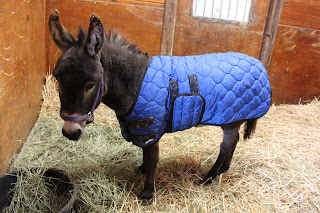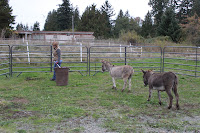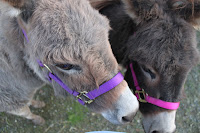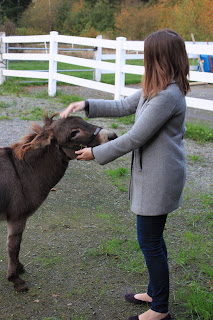Tonight was the first visit with the farrier since I've gotten them (A shout-out to Jim Williams of Tacoma for willingly coming and crawling around on his knees to trim these shorties!) and it went relatively well, considering their histories.
 |
| Cody's left front foot in September |
Cody was first up and investigation was underway to figure out why he is lame in his front-end. After some minor wrestling and some education on donkey feet (thanks again, Jim!), a small drainage tract was discovered in his right front foot, though it appeared to be dried up. He definitely was more resistant to having that foot picked up but they will sometimes be like that if the opposite foot is painful so, I am not totally sure if it was an abscess. More investigation is required. I looked at his x-rays again that were taken a few months ago and marveled at how horrendous his feet were, and are. His coffin bones (the last bone of their leg) in his front feet are horribly disfigured and the hoof capsules are also pretty messed up. Jim thinks that after a few more trimmings we will be able to get him pretty squared away, though his feet won't ever be normal; demineralized bone doesn't ever fix itself. All in all, Cody was a good boy and his feet are looking pretty good. I will have to reassess his lameness in the daylight.
 |
| Frida's feet when I first got her |
Frida was next and she showed her maturity by standing quite nicely for the majority of the trim. She had a few moments of naughtiness but, she is a donkey... Her feet were also atrocious when she was seized by animal control. Horribly, grossly overgrown with some severe arthritic changes on the end of her coffin bone of her left front and some significant demineralization of the right front; even her back feet were way too long! When she was first trimmed by a farrier, he broke out a small saw to take off the overgrown hoof! Her feet are in decent enough shape, though they also will require some work to get them to the place they should be.
Frida's feet in September, prior to the saw
Vida was the naughtiest of them all, though likely due to a lack of handling and experience. She was jumping and backing and rearing like a little donkey-bronc! Jim had extraordinary patience with her and with a bit of work, she ended on a good note by standing quietly but for one slip-up and having her last foot trimmed. Thankfully her feet are in pretty normal condition so they didn't require a lot of work. She and I have a date for some training in a few weeks when I am back on my feet and more mobile.
Dr. Arnold and Marissa went out to my place today to take some blood from the girls to send in for a pregnancy screen. Originally Marissa was going to come this evening and practice gathering blood samples but she and Dr. Hagerman worked extremely late yesterday (till 10 pm!) over in central Washington so she only worked a short day. There was a bit of downtime so I suggested that they go and do it without me. Donkeys are tricky to hit a vein on as they have a large muscle running across their jugular vein in their neck so you have to try to hit the vein either on the upper third or lower third of their neck. Marissa attempted on Frida but I guess she was a little squirmy so Dr. Arnold ended up taking the samples on the both. Maybe next time... I learned to take blood and give intravenous injections on newborn foals and youngsters which is really challenging since they have smaller, rolypoly veins and the are very spastic and jump when you poke them. It was a great way to learn!
So, I will send off the blood samples on Monday and we will see if either of them are in foal. One interesting thing: when I spun the blood down to collect the serum and plasma out of the tubes, I discovered that in this case their serum/plasma was virtually clear whereas in horses it is typically tinted a medium yellow color. I am not sure if this is normal since we don't collect blood on donkeys very often but it was curious and I think I will try and find out!














































